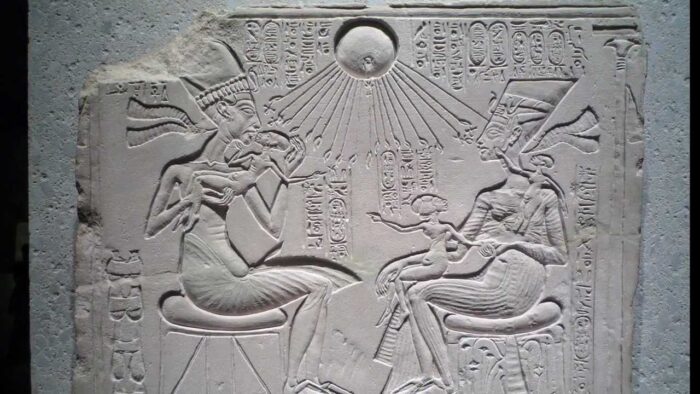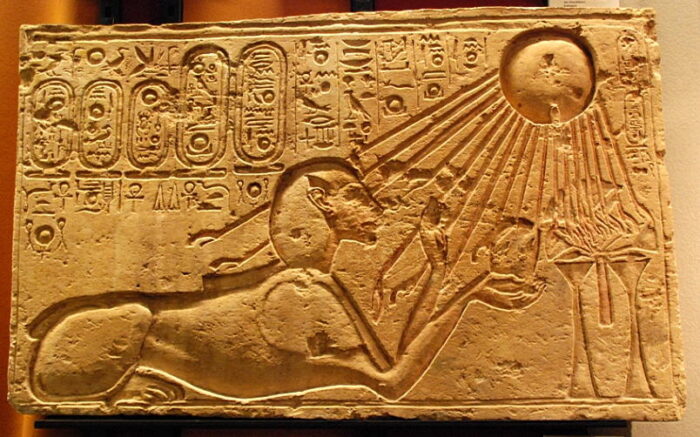
Hello everyone! Here I am. My name is Akhenaten. Does my name sound familiar to you?
My birth name is Amenhotep IV, which means “Amun is satisfied”, but I renamed myself as “Akhenaten”, to follow my will of worshiping the sun god Aten. I was never a person who loved stability, and renaming myself was only one of the first steps that initiated a series of changes to the state of Egypt. I ardently believed in monotheism, and I worshiped the sun god Aten. I wanted my people to do the same, so I converted the religion of ancient Egypt from polytheism to Atenism.
My family and I lived around 1350 BCE. I had a beautiful wife, and three lovely daughters, and I loved them very much. When I wasn’t tackling work, I spent time with my family under the illumination of Aten, the sun disk, as I believe that the sun disc will enlighten me and bring happiness to the ones whom I love.

Fg.2. The Aten and the sun disk
I want to talk about the portrait of my family, especially in terms of religion. The sun disk on top of our heads symbolized Aten, and the cobra indicated that Aten was our sole deity. Basking in the warmness poured down, we enjoyed our time together under the honorable sunshine. For me, the rays of light have hands attached at the end, and the rays of light that reached the nose of me and my wife are even more majestic: they have ankhs at their terminals. Ankhs symbolize life, and ankhs pointing to the nose indicated that Aten was pouring down life to where we breathe. I felt deeply blessed, and so did my wife.
Fg.3. The Ankh, the sign of life in Egypt
I loved my wife, and we wanted to rule Egypt cooperatively. The fact that we were both sitting on the throne but on different thrones demonstrates this idea. Papyrus and reeds are apparent under Nefertiti’s throne, which symbolized the union of upper and lower Egypt, and our wish to rule Egypt as a coherent whole.
Fg.4. Papyrus and reed under the throne of Nefertiti, New Kingdom, Amarna period, 18th dynasty. C.1350 BCE
Fallacy!
Some people argue that the anatomy of the plaque of our family was problematic, such as our extremely thin limbs and weirdly-shaped skulls. However, I did not think so. It was the usual portrait of our bodies that distinguished us from Egyptian art in the past and that made the Aten-centered art and religion stand out. A plain, domestic moment of my life was captured, and, to my satisfaction, my religious belief was clearly shown.
I felt offensive when I heard you modern people discussing me as a “heretic“, and let me tell you the truth! I moved the capital of Egypt from Thebes to Amarna because Aten had ordered me to do so. The cliffs that frame Amarna look like the Axt symbol, which means horizon. I felt that if the capital of my country located somewhere that embraced horizon, where the sun rises everyday, my country and my people would be blessed everyday. I converted the religion of Egypt from polytheism to monotheism not because of, as many had asserted, my radical nature, but because of my experience in my early years. Also, the idea of creating a sacred place for the sun god, the “Great Palace” of Karnak, rooted in my mind when the orientation of the palace was reversed to the east, leaving a vacant land for the sun.
Also, I wrote a hymn for our beloved Aten, and here is a brief excerpt of it. Check it out if you like it!
“You rise in perfection on the horizon of the sky,
living Aten, who started life.
Whenever you are risen upon the eastern horizon
you fill every land with your perfection.”
Note: Xinran Wang is from Qingdao, China and is a member of Colgate Class of 2026. I’m currently undecided, but I am interested in art history. I have been curious about the mysteries of ancient Egypt since I visited the British Museum years ago, so I chose to write and explore a very small portion of ancient Egypt from the perspective of a pharaoh.